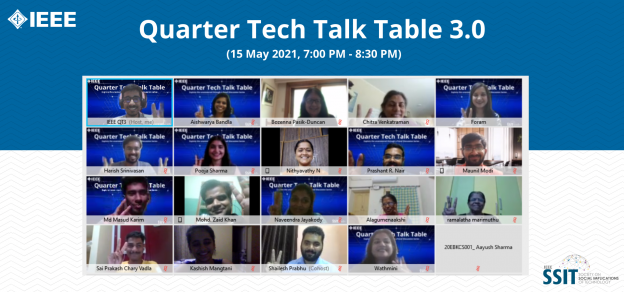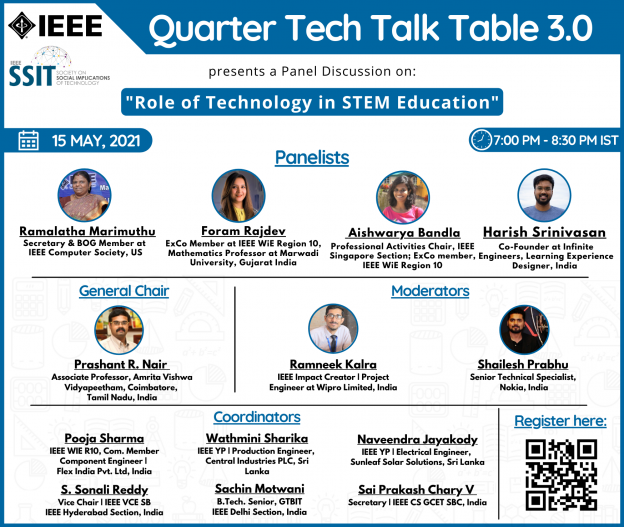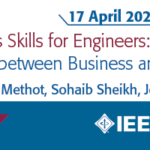Prepared by: Ramneek Kalra, IEEE Impact Creator & YP, and Shailesh Prabhu, IEEE YP
A group of IEEE Young Professionals & Impact Creators gathered on 15th May 2021 (07:00 PM – 08:30 PM IST) to create awareness on technology and form a collaborative environment by initiating “Quarter Tech Talk Table 3.0 (QT3)” in the form of a Panel Discussion on the topic “Role of Technology in STEM Education”. This was conducted in collaboration with “Universal Access to Technology” (Technical Committee) of IEEE SSIT.
Motivation: To create a broad collaborative group of Young Professionals and Impact Creators to share some insights on cutting-edge technologies to all technology enthusiasts by having a panel discussion. The primary motivation of QT3 comes from the IEEE Strategic Plan 2020-2025 which inspires us to conduct this event with no boundaries. This provides opportunities to volunteers who collaborated to make this event a grand success.
Objectives: The objectives of QT3 are as stated below:
●Creating a broad collaboration for sharing knowledge of Industrial Technologies.
●Creating a bridge to connect IEEE Young Professionals through this activity for career and professional development.
●Sharing opportunities for elevating ideas using research based oriented learning.
●Creating an open forum for discussion on recent technological advancements and challenges.
Event Details: In continuation with the successful completion of the previous editions of QT3 back in November 2020 and February 2021, the prominent IEEE Young Professionals and Impact Creators across the globe once again came together for a panel discussion in the third edition of QT3 held on 15th May 2021..
Discussed Points:
Some of the key takeaways from this 3rd edition of QT3 are as listed below:
–STEM education has resulted in better understanding of society and the action plans that are to be implemented to solve the same can be achieved.
–Students and faculties acquire the chance to learn from each other by means of STEM and developing technology.
–The education system involving STEM from the initial stages can produce potent individuals in the future.
Round 1 (Open Mic: Discussion on the Role of Technology in STEM Education)
◦ The panel discussion was initialized with the panelists’ perspective about STEM and the method of education that is being followed these days. Commencing the discussion, one of the panelists shared their views about the interdependency of STEM and educational revolution.
◦ In addition to the opinion put forth by the previous panelist, another panelist spoke about the importance of STEM as an enabler and a helping hand for scientists and technologists. The person highlighted the fact that “STEAM” is much preferred to “STEM”.
◦ The essential inter-relation between STEM and current technology was highlighted by a panelist. Ensuring the understanding of STEM education, various technological tools such as simulation, machine learning, data analytics and interpretation were incorporated. Therefore proving that technology plays an essential role in updating STEM education.
◦ The next panelist pointed out the accessibility of technology and connectivity it brings out irrespective of the geographic location people live in. The person too stressed the point that “STEM” is induced to form “STEAM”, meaning that the areas of art, architecture and management were also involved in the enhancement of education.
.
Round 2 (Closed Floor: Panel QA Discussion)
◦ The discussion started with a question to the panelists “Can technology bring ease of explanation of your own domain subjects for the students to understand?” One of the panelists initiated with her views stating that the use of technological tools like Tinkercad, Matlab, Fusion-360 and image processing has made it easy for the students to efficiently recognize the concepts in their own domain.
◦ Another panelist opened up that new updates on technology had turned learning into such a way that both the teachers as well as the learners were benefited by exchanging the concepts of current technology that is used to display the theories acquired through academics.
◦ Adding to the previous panelist’s point, one of the panelists established that the involvement of technology has been taken as an opportunity for the teachers to learn about the trend-setters. Various actions taken in order to bring multiple ways to solve a particular problem were put forward. The panelist also added that while implementing the same, the students will develop the ability to solve a problem, take risks, and initiate an idea in the future.
◦ Owing to the expertise the person achieved in IEEE, explanations about the aspects to increase STEM education in women pursuing their school and college were made. The essential aspects include technical skill, professional skill, social skill (networking) and volunteering.
◦ One of the panelists focused on the interdependence of research areas and STEM education. The panelist also elaborated the ways that researchers take to solve a particular problem. The additional points by the person include the levels of professionals such as T shaped or Pi shaped ones and the expectations of recruiters from the professionals to arrive at the solutions through new means.
.
Round 3 (Open Floor: Ask the Panelist)
Under this last section, the “Quarter Tech Talk Table 3.0 (QT3)” in the form of a Panel Discussion on the topic “Role of Technology in STEM Education” was open to the virtual delegates for the Q&A session. They were informative and worth seeking inputs from everyone. If you missed to attend the 3.0 Edition, feel free to explore on IEEE TV Platform at: https://ieeetv.ieee.org/video/ieee-quarter-tech-talk-table-30-ieee-qt3-initiative
With the ending of this QT3 3.0, the General Chair put together the thank remarks and shared the tentative next QT3 4.0 Schedule: 7th and 8th August 2021. We welcome all the readers to register for QT3 4.0 Edition at: https://forms.gle/x2ost6UqqBGiqtxJ6
.




